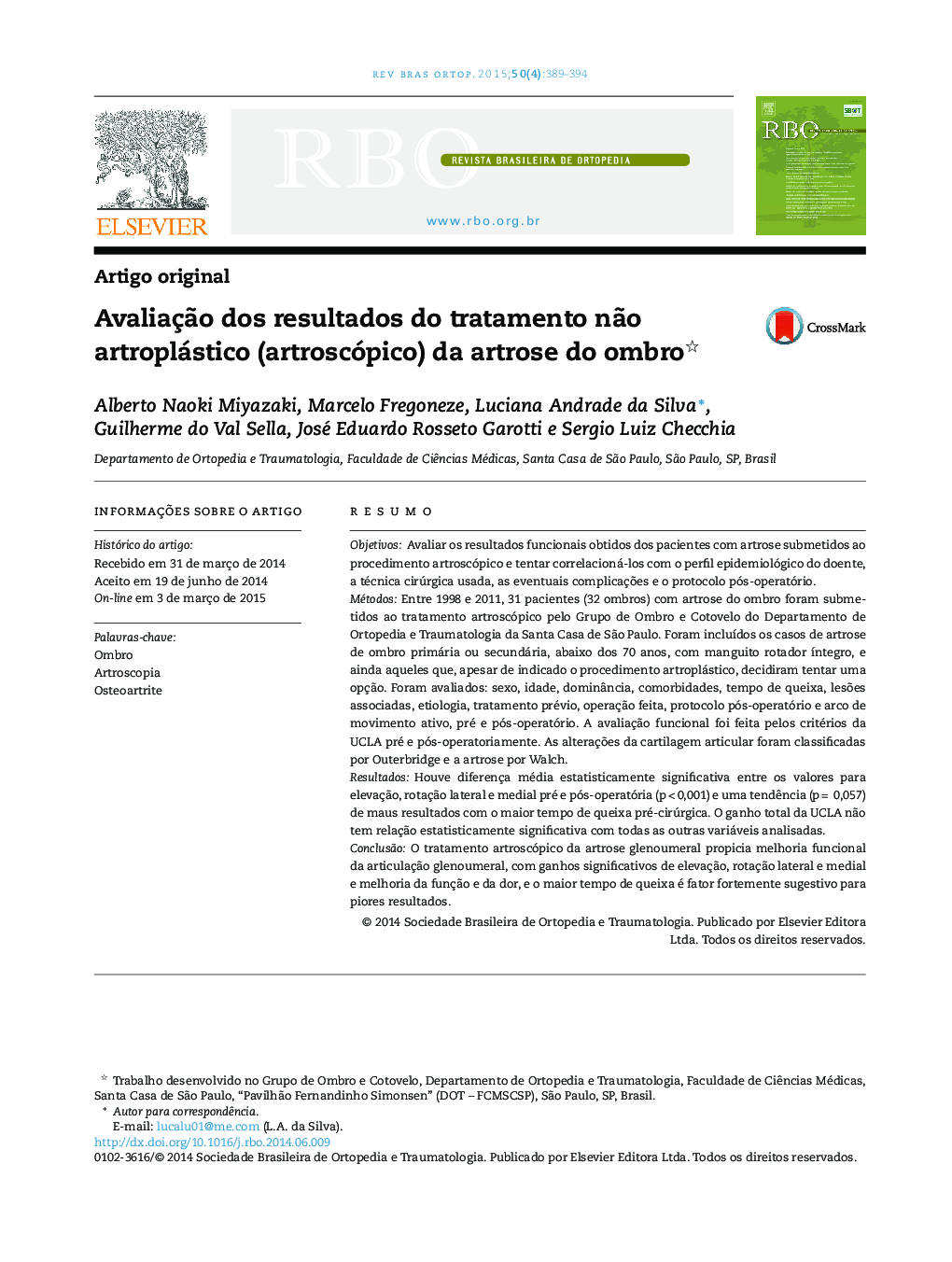| کد مقاله | کد نشریه | سال انتشار | مقاله انگلیسی | نسخه تمام متن |
|---|---|---|---|---|
| 2713220 | 1145146 | 2015 | 6 صفحه PDF | دانلود رایگان |

ResumoObjetivosAvaliar os resultados funcionais obtidos dos pacientes com artrose submetidos ao procedimento artroscópico e tentar correlacioná‐los com o perfil epidemiológico do doente, a técnica cirúrgica usada, as eventuais complicações e o protocolo pós‐operatório.MétodosEntre 1998 e 2011, 31 pacientes (32 ombros) com artrose do ombro foram submetidos ao tratamento artroscópico pelo Grupo de Ombro e Cotovelo do Departamento de Ortopedia e Traumatologia da Santa Casa de São Paulo. Foram incluídos os casos de artrose de ombro primária ou secundária, abaixo dos 70 anos, com manguito rotador íntegro, e ainda aqueles que, apesar de indicado o procedimento artroplástico, decidiram tentar uma opção. Foram avaliados: sexo, idade, dominância, comorbidades, tempo de queixa, lesões associadas, etiologia, tratamento prévio, operação feita, protocolo pós‐operatório e arco de movimento ativo, pré e pós‐operatório. A avaliação funcional foi feita pelos critérios da UCLA pré e pós‐operatoriamente. As alterações da cartilagem articular foram classificadas por Outerbridge e a artrose por Walch.ResultadosHouve diferença média estatisticamente significativa entre os valores para elevação, rotação lateral e medial pré e pós‐operatória (p < 0,001) e uma tendência (p = 0,057) de maus resultados com o maior tempo de queixa pré‐cirúrgica. O ganho total da UCLA não tem relação estatisticamente significativa com todas as outras variáveis analisadas.ConclusãoO tratamento artroscópico da artrose glenoumeral propicia melhoria funcional da articulação glenoumeral, com ganhos significativos de elevação, rotação lateral e medial e melhoria da função e da dor, e o maior tempo de queixa é fator fortemente sugestivo para piores resultados.
ObjectivesTo evaluate the functional results from patients with arthrosis who underwent an arthroscopic procedure, in an attempt to correlate these results with the patients’ epidemiological profile, surgical technique used, possible complications and postoperative protocol.MethodsBetween 1998 and 2011, 31 patients (32 shoulders) with shoulder arthrosis underwent arthroscopic treatment performed by the Shoulder and Elbow Group of the Department of Orthopedics and Traumatology of Santa Casa de São Paulo. Primary or secondary cases of shoulder arthrosis under the age of 70 years, in which the rotator cuff was intact, were included. Furthermore, cases in which, despite an indication for an arthroplastic procedure, an attempt to perform an alternative procedure had been chosen, were also included. The following were evaluated: sex, age, dominance, comorbidities, length of time with complaint, associated lesions, etiology, previous treatment, operation performed, postoperative protocol and pre and postoperative active ranges of motion. The functional evaluation was conducted using the UCLA criteria, before and after the operation. The joint cartilage alterations were classified in accordance with Outerbridge and the arthrosis by means of Walch.ResultsThere were statistically significant mean differences in the values for elevation, lateral rotation and medial rotation from before to after the operation (p < 0.001) and there was a tendency (p = 0.057) towards poor results with greater length of time with complaints before the surgery. The total gain in UCLA score did not have any statistically significant relationship with any of the other variables analyzed.ConclusionArthroscopic treatment of glenohumeral arthrosis provided functional improvement of the glenohumeral joint, with significant gains in elevation and lateral and medial rotation, and improvements in function and pain. Greater length of time with complaints was a factor strongly suggestive of worse results.
Journal: Revista Brasileira de Ortopedia - Volume 50, Issue 4, July–August 2015, Pages 389–394